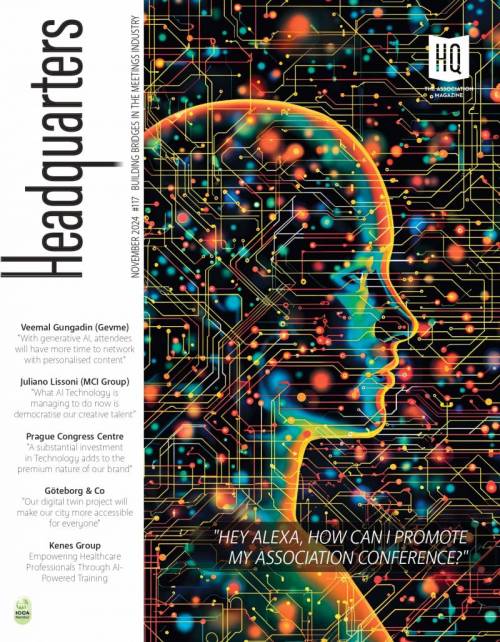How digitalisation is a game changer for professional associations

We live in a world where digital communications are owned and can be seen by everyone, and the benefits of membership are no longer ‘just in the hands of associations’ in a digitally networked society, writes Chloe Menhinick, network engagement manager of International Water Association and board member of ESAE.
 In our digital, networked society, the personal and the professional have become less distinct; people share content more freely and are pushing increasingly for open access; the Freemium model has created opportunities for quality content to be accessed at no cost, forcing business to move away from the traditional content-for-cash approach to optimise alternative revenue streams. Content has become available through a myriad of channels, virtual platforms and social media. The growth of these virtual communities and digital media allows people to network in unprecedented ways and at unprecedented speed.
In our digital, networked society, the personal and the professional have become less distinct; people share content more freely and are pushing increasingly for open access; the Freemium model has created opportunities for quality content to be accessed at no cost, forcing business to move away from the traditional content-for-cash approach to optimise alternative revenue streams. Content has become available through a myriad of channels, virtual platforms and social media. The growth of these virtual communities and digital media allows people to network in unprecedented ways and at unprecedented speed.
As the landscape of associations continues to change, we are experiencing a transformation in the way we do business and the way we engage with our stakeholders. The evolution of the digital world has challenged the traditional value propositions of membership. The digitalisation of membership services and communities must become an inherent part of the membership engagement experience.
Engagement is the key
An association with a clear purpose needs to be able to communicate with and engage its current and future stakeholders, the members of today and supporters of the future. It needs to not only be an authoritative voice within its existing networks, but to be able to influence people from outside its traditional audiences on issues central to achieving its vision.
Also, in our networked world it has become a necessity just to remain relevant. Digitalisation offers associations a wealth of new opportunities to enhance our engagement tactics, and in doing so, to redefine and enhance our value propositions for membership.
Considering the fact that many associations struggle to find support (and resources) to begin the journey at all, even for those who are already embracing digital communication, the questions of “How much?”, “How far?” and “How fast?” they need to travel to remain relevant are fraught with challenges.
Some of the most widely used online professional and social networks, including LinkedIn, Facebook, and Wechat, present themselves as cheap, quick and effective options for associations. One way to determine how deep your digital offering should go is to consider the breadth of content covered, the number of members and the variety of internal member groupings. Guiding questions to frame your discussion include: What is your vision in offering a digital proposition? Which offering is best placed to meet that vision? Do existing online networks provide enough opportunities to engage, network and collaborate? Is this sufficient to accelerate and maximise your impact? Will it enhance the sense of belonging so fundamental to the concept of membership?
For some associations, the answer will be “yes”. For others, whose structure and breadth of internal communities are far-reaching and complex, a dedicated online community platform may be the solution to strengthen their value proposition and help propel them association into the future.
The opportunities of digitalisation:
Increase your sphere of influence
Havingmembers, non-members, stakeholders, cross-cutting disciplines and even interested public follow, engage or just be exposed to your position and messaging, is vital to modern lobbying. A digital proposition will enable you to broaden the audience with which you actively engage, and facilitates engagement and collaboration beyond your traditional networks, ensuring that the influence and relevance of your association is amplified.
Inclusivity
Online communities can empower your members to have a voice in the running of the association, not just those in leadership positions. Introducing new members to the community through a dynamic and active on boarding strategy can be effective and empowering. If some member groupings are stagnating, encourage more diversity by inviting new members to post comments, questions and content that prompts wider engagement.
This is not to replace the thriving offline communities that are typically the lifeline of associations, but leverage that energy online to reach a wider audience. For example, events can be used to engage non-attendees through online activities. The live streaming of sessions, live reporting and soliciting questions from the online community, can reduce the negative influence distance and cost of events can have on a member’s ability to engage.
Member Recognition
Enabling members to become ambassadors, with meaningful reward for their efforts, is central to a thriving association. For members to thrive and succeed though, we need to provide the tools that are right for them. Embracing change hard, but focusing our energies on empowering, rewarding and recognising early adopters can help us move forward. Written or video interviews with a cross section of your active community offer a relatively low cost, highly effective benefit for your early adopters. We can easily identify and nurture early adopters, ensuring that the value proposition of any change is clear and tangible. Dissemination of new ideas and content is accelerated through tactics of reposting, sharing comments and liking.
Create a hub for inspiration
Sharing information, developing new content, and creating a place where members can work outside traditional structures, can help break out of ingrained silos; and can encourage cross-fertilisation between areas of interest that enrich learning and accelerate impact. Creating additional opportunities to network and collaborate can add value to membership.
Drive conversion
Digitalisation allows associations to embrace different types of Freemium models, providing some benefits of membership to non-members. In the connected world where content and networking are often free, this gives you an opportunity to engage with individuals differently, allowing them to try and test whether the association would be valuable to them. Freemium models can enhance the reputation of associations and support conversions to membership.
Conclusion
While going digital is not a panacea for associations, no organisation will function effectively without it in the world today. Digitalisation is not about technology, but about member-centricity. Ensuring that your association continues to climb up the innovation curve may necessitate walking a fine line between long-term, loyal and influential members who are happy with business-as-usual, and young professionals with an appetite for active engagement and participation whose long-term loyalty has not yet been secured. In resource-constrained, risk-averse environments, many associations are walking this fine line trying not to tip of the scales too far in one direction at the expense of the other.
Overcoming this requires all functions within an association to be working towards the same goal of maximising engagement of current and future stakeholders. It requires the senior leadership to ensure its focus remains on working towards meeting the collective needs of membership. Listening to influential and vocal voices is important, but so is engaging the youngest professionals in dialogues concerning the future of their association. What would they do if they were to create your association today? How would it look, how would it function? What would their vision be?
As association leaders, we need to identify ways to reward innovation and creativity, and commit to the long-term gain over short-term needs. Innovation is not just about technology but about constantly reviewing the ways in which we engage with our members and other stakeholders. We must ensure we are not doing something just because that’s the way it’s always been done. Instead, we must identify the best way to work towards achieving our vision and mission.
Our ability to adapt and respond quickly to the ever-changing tides and currents of the digital world will be a determining factor in our success. If we aren’t providing the platforms for our members to connect virtually, the likelihood that someone else will is almost inevitable.
Other Articles
About Us
Supported by the Union of International Associations (UIA), the International Association of Professional Congress Organisers (IAPCO) and the Interel Group, the global public affairs and association management consultancy, Headquarters Magazines serve the needs of international associations organising worldwide congresses.














